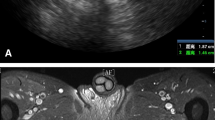Abstract
The study was designed to evaluate computerized eight-channel vector manometry (8CVM) and pelvic floor magnetic resonance imaging (MRI) as methods to assess the anal sphincter following posterior sagittal anorectoplasty (PSARP) for anorectal malformations, in particular the functional capacity of the sphincter structures in correlation with postoperative MRI findings. Seventeen children had been operated upon for a rectovesical, -urethral, or -vaginal fistula including one female cloacal malformation; 4 had a secondary PSARP. Mean follow-up was 5.57 years. Continence was evaluated with a modified Kelly score. A CVM technique with an eight-channel perfusion catheter was used. In addition to software-supported data, the manometric parameters included a score-system assessing three different pressure zones of the anal canal qualitatively on the three-dimensional image of the anal sphincter profile. The same procedure was performed on sagittal, oblique axial, and oblique coronal MRI. Furthermore, the thickness of the sphincter muscle was assessed at the level of the maximal mean segmental pressure. All children had decreased absolute vector-volumetry values at rest and on squeezing. Correlation with the clinical score was poor. Correlation of the manometric score with the clinical course was similar to the correlation of MRI score with clinical course (R = 0.425; P = 0.1). Thirteen children demonstrated normal or increased sphincter length; 5 of these had a decreased high-pressure zone (HPZ). The position of the anorectum in the sphincter muscles could be evaluated by the vector-volumetry image as anatomic in 11 cases, nearly correctly positioned in 4, and ectopic in 1 child. MRI detected 2 cases of malposition, 10 anatomic, and 4 nearly-anatomic findings. Correlation of the manometric score with the MRI score and the thickness of the sphincter muscle at the HPZ was significantly high (R = 0.801; P < 0.0001). 8CVM is thus highly sufficient in illustrating the function of the sphincter musculature seen on pelvic floor MRI. Both methods only moderately reflect clinical follow-up, since continence depends on more than sphincter ability.
Similar content being viewed by others
Author information
Authors and Affiliations
Additional information
Accepted: 9 March 2000
Rights and permissions
About this article
Cite this article
Schuster, T., Lagler, F., Pfluger, T. et al. A computerized vector manometry and MRI study in children following posterior sagittal anorectoplasty. Pediatr Surg Int 17, 48–53 (2001). https://doi.org/10.1007/s003830000437
Issue Date:
DOI: https://doi.org/10.1007/s003830000437




